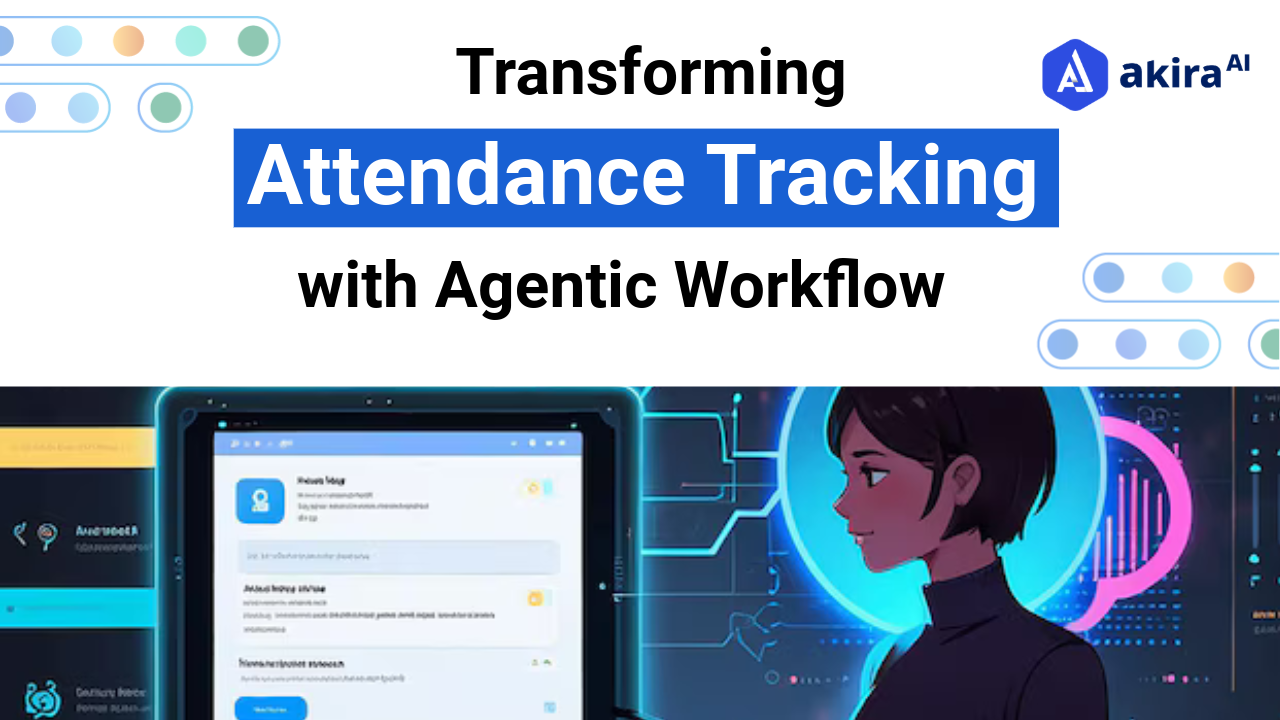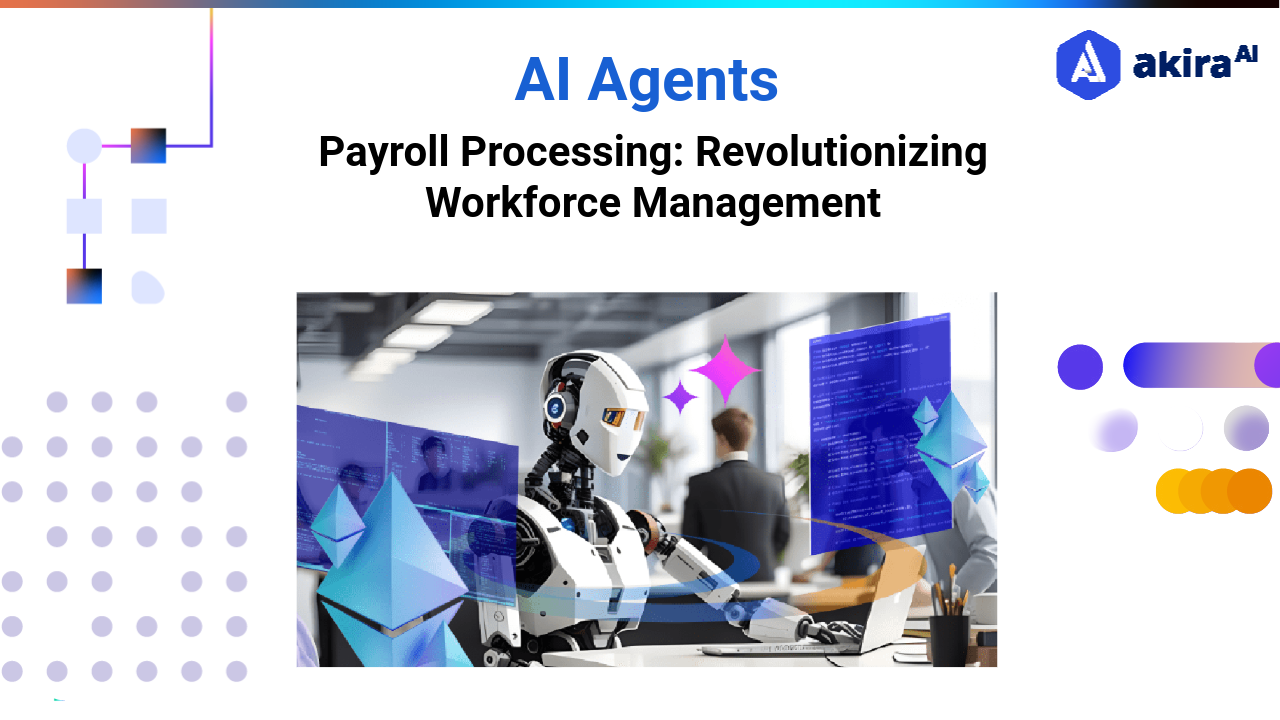In today's fast-paced business landscape, the integration of AI Agents-driven solutions has become a game changer with increased innovation and success. Generative AI has been making a significant impact across a number of sectors, and payroll is no exception.
This blog explores how the multi-agent system of Akira AI reinvents payday processing with innovative AI-driven solutions that meet age-old payroll challenges. So let us dive into the details of how AI agents are reshaping the future of payroll processing.
Brief Overview: Key Concepts of Payroll Management
AI Agents
AI Agents are computer programs designed to perform tasks autonomously by making decisions based on their environment, input, and specific objectives. Unlike traditional automation systems that rigidly follow predefined instructions, AI Agents can think, adapt, and act independently. They can assess their surroundings, learn from previous experiences, and make decisions to achieve particular goals.
This range from simple programs that handle single tasks to sophisticated systems that manage complex processes. They thrive in unpredictable environments, leveraging their learning capabilities to navigate the internet, interact with applications, process vast amounts of data, engage in transactions, and continually refine their methods based on feedback.
AI Agents In Payroll
AI Agent's payroll processing is powered by LLM (Large Language models) software systems that can take action. They utilize traditional machine learning techniques, various APIs, and tools to automate the payroll process.
The AI-driven agents are transforming payroll management by taking on responsibilities that traditionally required human intervention, such as calculating salaries, processing deductions, and managing tax withholdings. They ensure precision and compliance with payroll regulations, significantly reducing the risk of errors and the potential for bias in manual processes. These AI agents improve the overall payroll experience by providing prompt and accurate responses to employee inquiries, offering real-time support, and ensuring that any issues are resolved quickly.
Navigating Payroll Challenges
Management of payroll is a very complex set of procedures. Doing so incorrectly can create tremendous, significant problems for an organization. Among the main issues are:
-
Data Integrity and Integration: The payroll loads data from many different systems, such as attendance, HR data, and financial systems. Ensuring that this data is fully integrated without discrepancies is a significant challenge.
-
Compliance with Tax Laws and Regulations: Tax laws are subject to rapid changes, which mandates much vigilance. Not following rules and procedures can always lead to penalties and even possible legal complications.
-
Employee Enquiry Handling: Employee payroll enquiry handling and response are carried out efficiently to maintain morale, which generally adds to the administrative workload.
-
Scalability: Payroll management gets difficult as organizations grow since the workforce is increasing, with variable requirements.
-
Data Security: Payroll data is very sensitive, and tight security is needed against penetration or unauthorized access.
AI agents can address these payroll challenges effectively by seamlessly integrating data from multiple sources like attendance, HR, and financial systems, ensuring consistency and accuracy and eliminating discrepancies. AI-driven systems also stay updated with the latest tax laws and regulations, automatically adjusting calculations to remain compliant, reducing the risk of penalties and legal issues. AI agents can manage and respond to employee payroll inquiries in real time, reducing the administrative burden while maintaining employee satisfaction.
Akira AI: Multi-Agent in Action
Akira AI’s multi-agent payroll system revolutionizes payroll processing by automating every aspect of the payroll cycle. The system comprises an agentic workflow with several specialized AI agents, each designed to handle a specific task within the payroll process.
.png?width=1050&height=604&name=image%20(1).png)
Fig1: Architecture Diagram of Payroll Processing
It includes unique, specialized agents with precise roles within the payroll processing industry. These agents work together to speed up processing and improve decision-making accuracy spike.
-
Specialized Agents with Defined Roles: The MAS is built around role specialization. Each agent has a specific job, which is to extract data to validate documents and make decisions.
-
Using Knowledge Graphs for Better Understanding: The MAS uses knowledge graphs to make better decisions. These graphs map relationships between data points within a claim, helping agents understand the full context. For example, they can see how a policy is connected to an incident and the relevant coverage terms, leading to more informed decisions.
-
Real-Time Processing and Decision-Making: Akira AI’s MAS can process data and make decisions in real-time. We can constantly monitor incoming data and adjust the workflows, and the system will react to changes as they happen, ensuring that claims are processed quickly and accurately.
The Multi-Agent System in Action
-
Data Ingestion and Preprocessing: The Data and Validation Agent uses machine learning-enhanced ETL processes to ingest, clean, and validate data from HR, time tracking, and finance systems. It employs NLP and anomaly detection to process unstructured data and identify inconsistencies.
-
Intelligent Payroll Calculation: A Payroll Calculation Agent powered by a domain-specific LLM automates accurate payroll computations, including gross pay, deductions, and bonuses, using reinforcement learning for optimization. It securely disburses salaries through integrated banking systems.
-
Compliance Assurance: The Compliance Reporting Agent leverages rule-based systems, machine learning, and knowledge graphs to ensure regulatory adherence, interpret policy changes, and detect compliance issues through automated reasoning.
-
Error Resolution: The Query Resolution Agent uses Retrieval-Augmented Generation (RAG) and semantic search to resolve payroll issues, provide explainable recommendations, and automate escalation for complex cases requiring human intervention.
-
Human-AI Collaboration: The Agentic Payroll Workflow Interface employs NLU, computer vision, and generative AI to interpret instructions, analyze documents, and create readable reports for seamless collaboration between AI and payroll teams.
Technological Stack
Our composite AI framework utilizes the components from traditional Machine learning to advance Multi-agent systems:
-
Multiagent Layer: Advanced agent frameworks like LangChain, LangGraph, and Autogen are utilized to develop sophisticated agents. Retrieval Augmented Generation (RAG) pipelines leverage LangChain, Llama Index frameworks, and Knowledge Graphs for enhanced decision-making.
-
ML Integration: Integrated Document Processing (IDP) combines Optical Character Recognition (OCR) and Named Entity Recognition (NER) to streamline document handling and improve data accuracy.
-
Data Layer: Robust data pipelines employ PostgreSQL for structured data management and Qdrant for efficient vector data processing, ensuring seamless data integration and accessibility.
-
Backend and Frontend Excellence: Backend pipelines are built using industry best practices for secure, scalable APIs, while the user interface focuses on delivering a secure, user-friendly experience.
-
Infrastructure Layer: Flexible infrastructure options, including on-premises, cloud-based, and hybrid solutions, are employed to meet diverse operational needs and ensure optimal performance.
Seamless Integration with Existing Systems
1. Perfect Match: Compatibility of HRMS and ERP
Akira AI's multi-agent system is built with a seamless interface to existing HRMS and ERP systems across platforms.
For example, Global Corporation X uses SAP ERP and Workday HRMS. In this regard, Akira AI's Data and Validation Agent would best suit the two systems.
2. Bridging Systems: API Integration
API integration also will enable the system to interface with other utilities and third-party systems to provide one integrated payroll processing solution. For instance, Organization Y runs in the cloud on different tools for different functions. The Akira AI Compliance Reporting Agent interfaces with the following:
A) Zoho for basic payroll information
B) Expensify data for reimbursement
3. Custom Workflows Designed Around Your Business
Akira AI can provide the feature of customized workflow matching and moulding to fit your unique organizational structure, making payroll processes for employees as flawless as possible.
Benefits of Agentic Workflow
Implementing Akira AI’s multi-agent payroll system offers numerous benefits, including:
Improved Data Accuracy and Integration: Since data intake and verification are automated, there are fewer errors, making payroll data more accurate and consistent.
Smarter Efficiency: Automating calculation and disbursement processes quickly speeds up payroll processing by as much as 70%, freeing the HR team to assume a more strategic role.
Compliance Assurance: This feature enables real-time state-of-the-art activities for proper payroll, thereby reducing penalties at the most updated regulatory limits.
Better Employee Morale: Timely and accurate payroll processing paired with efficient query handling improves morale and is synonymous with increased faith in the organization.
Scalability: It should be able to grow in an organization where an increased workforce and further complicated payroll requirements are handled without much fuss.
Data security: The system's highly advanced security features ensure sensitive payroll data is secure against breaches.
Conclusion: AI Agents for Payroll Processing
Akira AI can easily compete with probably the most innovative leap in workforce management as an all-multi-agent payroll processing system. It economizes business, adding speed, accuracy, and security to scaling business objectives with everything automated, from gathering data to checking compliance. In a business world full of demands for efficiency and compliance, upgrading one's system to put oneself on par with such dimensions is not a business improvement but a challenge to livelihood relevance.

.png)
